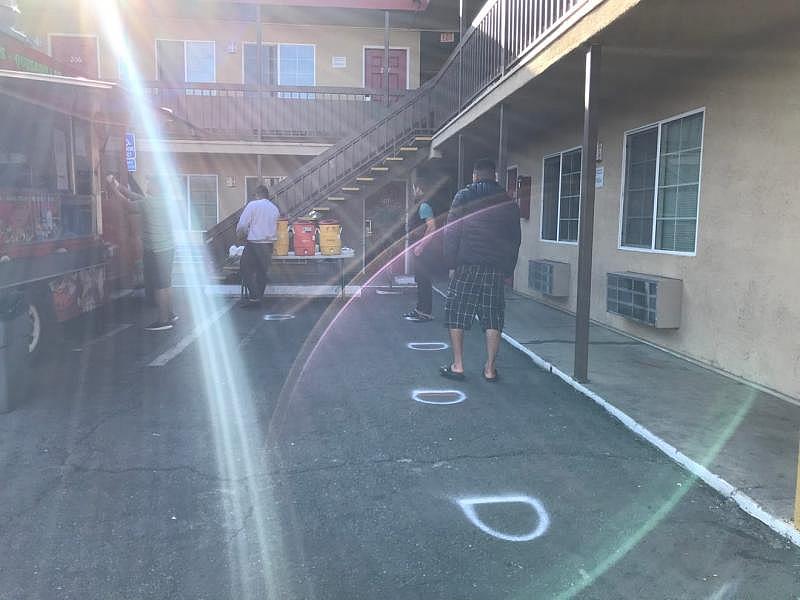In America’s Salad Bowl, crowded housing leaves farmworkers especially vulnerable to COVID-19

Foothill Packing workers gather in April for their dinner at the Budget Inn Motel on John Street in Salinas, observing social distancing lines drawn on the pavement.
(Photo by Kate Cimini/ The Salinas Californian)
A source I worked with in 2019 and early 2020 on a series on farmworkers and overcrowded living conditions returned home when the pandemic closed her university. Six months later, she is still sleeping in a bunk bed in the living room she shares with her little brother.
Nine other people live in that two-bedroom apartment. Half of them are under 10 years of age. Because of that overcrowded home — and her father’s job in agriculture as an essential worker — they’re more susceptible to COVID-19 than the average person.
My project looking at health and overcrowding began with support from the Center for Health Journalism's 2019 Impact Fund, when I looked at infectious diseases and overcrowding as part of a series on how California’s farmworkers still manage to make a home for themselves in inhospitable, overcrowded houses.
I connected with a few key farmworkers, but barely scratched the surface. I came back to the Center for Health Journalism with a similar pitch for another series, which was awarded a grant from the 2020 California Fellowship. This time, though, I would study diseases with a less obvious link to overcrowding: diabetes, mental health impacts, and so on. But soon, the pandemic made the original project I pitched seemed shortsighted. I would be ignoring the biggest story of the day — if not the century — by refusing to incorporate COVID-19.
I quickly switched the project’s focus to examine farmworkers, housing, and COVID-19.
At the time, scientists lacked data but believed there was indeed a link between overcrowding and the novel coronavirus. Now, after nearly a year of data, it’s clear that overcrowding is a significant contributor to the spread of COVID-19. My project followed this development in real-time. The more I reported on the link between overcrowded housing and COVID-19, the clearer it became.
California farmworkers have proven particularly vulnerable to the virus, as they often live in overcrowded housing, travel in groups to and from work, and typically lack access to health insurance. Monterey County has been a particularly good place to study these dynamics, as it is one of the few counties to separate out people infected by profession, allowing a window into the dangers wrought by overcrowding.
This led to another question: What barriers were preventing additional affordable housing or farmworker-specific housing from being built?
With the help of Center for Health Journalism engagement editor Danielle Fox, I convened an advisory group consisting of growers, housing advocates, farmworker advocates and direct service providers to pose that exact question. We met monthly from May to September and talked not only about problems direct service providers were witnessing and learning about from their clients, but also from growers and housing advocates about barriers to building more affordable housing — and housing specifically for farmworkers.
That helped shape reporting as I moved forward. I eventually connected with a local woman who had been evicted during the pandemic. Her story inspired California state Sen. Anna Caballero (D-Salinas) to write an extension to Assembly Bill 3088, extending renter and small-landlord protections further into 2021.
Furthermore, based on feedback from the advisory board, I took time to write a solutions-based story looking at areas around the state that had already successfully (or semi-successfully) created paths to increase affordable housing for local farmworkers, which received positive feedback from local elected officials and advocates.
I’d encourage everyone interested in reporting on the link between housing and COVID-19 to consider the following suggestions:
-
Take a look at the rate of overcrowding in communities near you through census date.
-
Consult county health departments about the most prevalent diseases exhibited among patients living in overcrowded homes.
-
Take out ads in the paper, send out flyers, post on social media sites such as Craigslist, Facebook, Twitter, Whatsapp and Instagram, and do the shoe-leather reporting to connect with people experiencing the issue you’re focusing on. Oftentimes, people in these living situations can be reluctant to talk for fear of jeopardizing their housing, so be patient. It takes time.
-
Reach out to advocates repeatedly, even when you don’t need something (a quote, a source) from them. Build a two-way relationship.
-
Finally, remember that engagement work is difficult and a lot of work, but it worthwhile in helping build your paper’s relationship to the community.
Read Kaitlin Cimini's stories here.
